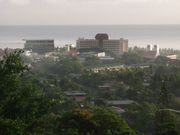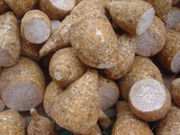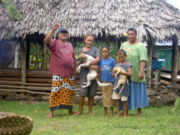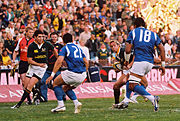Samoa
2008/9 Schools Wikipedia Selection. Related subjects: Oceania (Australasia)
| Malo Sa'oloto Tuto'atasi o Samoa Independent State of Samoa |
||||||
|---|---|---|---|---|---|---|
|
||||||
| Motto: Fa'avae i le Atua Samoa ( Samoan: "Samoa is founded on God") |
||||||
| Anthem: The Banner of Freedom |
||||||
|
|
||||||
| Capital (and largest city) |
Apia |
|||||
| Official languages | Samoan, English | |||||
| Demonym | Samoan | |||||
| Government | Parliamentary republic | |||||
| - | O le Ao o le Malo | Tufuga Efi | ||||
| - | Prime Minister | Tuilaepa Aiono Sailele Malielegaoi | ||||
| Independence | from New Zealand | |||||
| - | Date | 01 January 1962 | ||||
| Area | ||||||
| - | Total | 2,831 km² ( 174th) 1,093 sq mi |
||||
| - | Water (%) | 0.3% | ||||
| Population | ||||||
| - | July 2007 estimate | 214,265 ( 185th) | ||||
| - | Density | 65/km² ( 126th) 169/sq mi |
||||
| GDP ( PPP) | 2006 estimate | |||||
| - | Total | $1.218 billion ( 166th) | ||||
| - | Per capita | $6,344 ( 94th) | ||||
| HDI (2007) | ▲0.785 (medium) ( 77th) | |||||
| Currency | Tala ( WST) |
|||||
| Time zone | ( UTC-11) | |||||
| Internet TLD | .ws | |||||
| Calling code | +685 | |||||
Samoa, officially the Independent State of Samoa, is a country governing the western part of the Samoan Islands archipelago in the South Pacific Ocean. Previous names were Samoa from 1900 to 1919, and Western Samoa from 1914 to 1997. It was admitted to the United Nations on 15 December 1976. The entire island group, inclusive of American Samoa, was known as Navigators Islands before the 20th century because of the Samoans' seafaring skills.
History
Contact with Europeans began in the early 18th century. Jacob Roggeveen, a Dutchman, was the first European to sight the Samoan islands in 1722. This visit was followed by a French Explorer by the name of Louis-Antoine de Bougainville, the man who named them the Navigator Islands in 1768. Contact was limited before the 1830s which is when English missionaries and traders began arriving. Mission work in Samoa had begun in late 1830 by John Williams, of the London Missionary Society. By that time, the Samoans had gained a reputation of being savage and warlike, as they had clashed with French, British, German and American forces, who, by the late nineteenth century, valued Samoa as a refueling station for coal-fired shipping.
As the Germans began to show more interest in the Samoan Islands, the United States laid its own claim to them. Britain also sent troops to express its interest. There followed an eight-year civil war, where each of the three powers supplied arms, training, and in some cases combat troops, to the warring Samoan parties. All three sent warships into Apia harbour, and a larger-scale war seemed imminent, until a massive storm damaged or destroyed the warships, ending the military conflict. At the turn of the twentieth century, the Treaty of Berlin split the Samoan Islands into two parts: the eastern group became a territory of the United States (the Tutuila Islands in 1900 and officially Manu'a in 1905), and are today known as American Samoa; the western islands, by far the greater landmass, became known as German Samoa after the British gave up claims to the islands in return for Fiji and some Melanesian territories. The first German Governor was Wilhelm Solf who later went on to become Secretary for the Colonies of Imperial Germany. New Zealand troops landed in 'Upolu on August 29, 1914 and seized control from the German authorities, following a request by Britain that New Zealand forces take over a German radio station there.
From the end of World War I until 1962, New Zealand controlled Samoa as a Class "C" Mandate under trusteeship through the League of Nations. There followed a series of New Zealand administrators who were responsible for two major incidents. In the first incident, approximately one fifth of the Samoan population died in the Influenza epidemic of 1918-1919. In 1919 The Royal Commission of Inquiry into the Epidemic concluded that there had been no epidemic of pneumonic influenza in Western Samoa before the arrival of the 'Tahune' from Auckland on the 7th November, 1918 [which was allowed to berth by the NZ administration in breach of quarantine]; that within seven days of this ship's arrival pneumonic influenza had become epidemic in Upolu and had then spread rapidly throughout the rest of the territory.
The second major incident arose out of an initially peaceful protest by the Mau (literally translates as "Strongly held Opinion"), a non-violent popular movement which arose in the early 1920s to protest the mistreatment of the Samoan people by the New Zealand administration. The Mau was initially lead by Olaf Nelson, who was half Samoan and half Swedish. Nelson was eventually exiled during the late 1920s and early 1930s but he continued to assist the organization financially and politically. In following the Mau's non-violent philosophy, the newly elected leader, High Chief Tupua Tamasese Lealofi, led his fellow uniformed Mau in a peaceful demonstration in downtown Apia on December 28, 1929. The New Zealand police attempted to arrest one of the leaders in the demonstration. When he resisted, a struggle developed between the police and the Mau. The officers began to fire randomly into the crowd and a Lewis machine gun, mounted in preparation for this demonstration, was used to disperse the Mau. Chief Tamasese was shot from behind and killed while trying to bring calm and order to the Mau demonstrators, screaming "Peace, Samoa". Ten others died that day and approximately 50 were injured by gunshot wounds and police batons. That day would come to be known in Samoa as Black Saturday. The Mau grew, remaining steadfastly non-violent, and expanded to include a highly influential women's branch. After repeated efforts by the Samoan people, Western Samoa gained independence in 1962 and signed a Friendship Treaty with New Zealand. Samoa was the second or third Pacific Island country to become independent, after New Zealand and arguably Tonga.
In 2002, New Zealand's prime minister Helen Clark, on a trip to Samoa, formally apologised for New Zealand's role in these two incidents.
In July 1997, the constitution was amended to change the country's name from Western Samoa to Samoa, as it had been designated by the United Nations since joining the organization in 1976. The U.S. territory of American Samoa protested the move, asserting that the change diminished its own identity. American Samoans still use the terms Western Samoa and Western Samoans to describe the independent State of Samoa and its inhabitants. While the two Samoas share language and ethnicity, their cultures have recently followed different paths, with American Samoans often emigrating to Hawaiʻi and the U.S. mainland, and adopting many U.S. customs, such as the playing of American football and baseball. Western Samoans have tended to emigrate instead to New Zealand, whose influence has made the sports of rugby and cricket more popular in the western islands. Travel writer Paul Theroux noted that there were marked differences between the societies in Samoa and American Samoa. In Samoa the inhabitants, although poorer in terms of material wealth, were more content and retained a keen sense of Samoan identity, while American Samoans retained only the rhetoric of ethnic identity and in reality had sublimated their culture to western norms.
Politics
The 1960 Constitution, which formally came into force with independence, is based on the British pattern of parliamentary democracy, modified to take account of Samoan customs. Two of Samoa's four princely titles (paramount chiefs) at the time of independence were given lifetime appointments to jointly hold the office of head of state. Malietoa Tanumafili II had held this post alone since the death of his colleague ( Tupua Tamasese Mea'ole) in 1963. Malietoa Tanumafili II died 11 May 2007. He was the oldest living monarch at the time of his death. His successor, Tuiatua Tupua Tamasese Efi was selected by the legislature on the 17 June 2007 for a 5-year term.
The unicameral legislature ( Fono) consists of 49 members serving 5-year terms. Forty-seven are elected from territorial districts by ethnic Samoans; the other two are chosen by non-Samoans with no chiefly affiliation on separate electoral rolls. Universal suffrage was extended in 1990, but only chiefs (matai) may stand for election to the Samoan seats. There are more than 25,000 matais in the country, about 5% of whom are women. The prime minister is chosen by a majority in the Fono and is appointed by the head of state to form a government. The prime minister's choices for the 12 cabinet positions are appointed by the head of state, subject to the continuing confidence of the Fono.
The judicial system is based on English common law and local customs. The Supreme Court of Samoa is the court of highest jurisdiction. Its chief justice is appointed by the head of state upon the recommendation of the prime minister.
Political Districts
Samoa is made up of eleven itūmālō (political districts). These are the traditional eleven districts that were established well before European arrival. Each district has its own constitutional foundation (faavae) based on the traditional order of title precedence found in each district's faalupega (traditional salutations).
The capital village of each district administers and coordinates the affairs of the district and confers each districts' paramount title, amongst other responsibilities. For example, the District of A'ana has its capital at Leulumoega. The paramount title of A'ana is the TuiA'ana. The orator group which confers this title - the Faleiva (House of Nine) - is based at Leulumoega. This is also the same for the other districts. In the district of Tuamasaga, the paramount title of the district - The Malietoa title - is conferred by the FaleTuamasaga based in Afega.
|
|
1 including islands Manono, Apolima and Nu'ulopa
2 including the Aleipata Islands and Nu'usafe'e Island
3 smaller parts also on Upolu (Salamumu (incl. Salamumu-Utu) and Leauvaa villages)
Geography
The country is located east of the international date line and south of the equator, about halfway between Hawai‘i and New Zealand in the Polynesian region of the Pacific Ocean. The total land area is 2934 km² (slightly smaller than the U.S. state of Rhode Island), consisting of the two large islands of Upolu and Savai'i which account for 99% of the total land area, and eight small islets: the three islets in the Apolima Strait ( Manono Island, Apolima and Nu'ulopa), the four Aleipata Islands off the eastern end of Upolu ( Nu'utele, Nu'ulua, Namua, and Fanuatapu), and Nu'usafe'e (less than 0.01 km² in area and about 1.4 km off the south coast of Upolu at the village of Vaovai). The main island of Upolu is home to nearly three-quarters of Samoa's population, and its capital city is Apia. The climate is tropical, with an average annual temperature of 26.5 °C, and a rainy season from November to April. Savai'i is the largest of the Samoan islands and the third largest Polynesian Island after Tahiti and New Zealand. The population of Savali'i is 42,000 people.
Geology
The Samoan islands have been produced by volcanism, the source of which is a geologic hotspot which is the probable result of a mantle plume. While all of the islands have volcanic origins, only Savai'i has had recent eruptions and could be considered volcanically active. The last major eruption occurred in the 1700s, and smaller eruptions occurred between 1904 - 1906. The highest point in Samoa is Mauga Silisili, at 1858 m. The Saleaula Lava Fields were produced by Mt. Matavanu during its eruption 102 years ago leaving 52 square kilometres of solidified lava.
Economy
The economy of Samoa has traditionally been dependent on development aid, private family remittances from overseas, and agricultural exports. Agriculture employs two-thirds of the labor force, and furnishes 90% of exports, featuring coconut cream, coconut oil, noni (juice of the nonu fruit, as it is known in Samoan), and copra. Outside of a large automotive wire-harness factory (Yazaki Corporation), the manufacturing sector mainly processes agricultural products. Tourism is an expanding sector which now accounts for 25% of GDP. Tourist arrivals have been increasing over the years with more than 100,000 tourists visiting the islands in 2005, up from 70,000 in 1996. The Samoan government has called for deregulation of the financial sector, encouragement of investment, and continued fiscal discipline. Observers point to the flexibility of the labor market as a basic strength for future economic advances. The sector has been helped enormously by major capital investment in hotel infrastructure, political instability in neighboring Pacific countries, and the 2005 launch of Polynesian Blue a joint-venture between the government and Virgin Airlines.
Samoa is a fertile, fruitful, productive island. In the period before German colonization, it produced mostly copra. German merchants and settlers were active in introducing large scale plantation operations and developing new industries, notably cocoa and rubber, relying on imported laborers from China and Melanesia. When the value of natural rubber fell drastically, about the end of the Great War (World War I), the New Zealand government encouraged the production of bananas, for which there is a large market in New Zealand.
Because of variations in altitude, a large range of tropical and subtropical crops can be cultivated, but land is not generally available to outside interests. Of the total land area of 2,934 km² (725,000 acres), about 24.4% is in permanent crops and another 21.2% is arable. About 4.4% is Western Samoan Trust Estates Corporation (WSTEC).
The staple products of Samoa are copra (dried coconut meat), cocoa (for chocolate), and bananas. The annual production of both bananas and copra has been in the range of 13,000 to 15,000 metric tons. If the rhinoceros beetle in Samoa were eradicated, Samoa could produce in excess of 40,000 metric tons of copra. Cocoa is of very high quality and used in fine New Zealand chocolates. Most cocoa trees are Criollo-Forastero hybrids. Coffee grows well, but production has been uneven. WSTEC is the biggest coffee producer. Rubber has been produced in Samoa for many years, but its export value has little impact on the economy.
Other agricultural industries have been less successful. Sugarcane production, originally established by Germans in the early 20th century, could be successful. Old train tracks for transporting cane can be seen at some plantations east of Apia. Pineapples grow well in Samoa, but beyond local consumption have not been a major export.
Components of the economy
Gross Domestic Product (GDP) in purchasing power parity (PPP) in 2006 was estimated at $1.218 billion USD. The industrial sector is the largest component of GDP at 58.4%, followed by the services sector at 30.2% (2004 est.). Agriculture represents only 11.4% of GDP (2004 est.). Samoan labor force is estimated at 90,000.
Demographics
According to the CIA World Factbook, Samoa has a population of 214,265 of which 92.6% are Samoans, 7% Euronesians (persons of European and Polynesian blood) and 0.4% are Europeans. About three-quarters of the population live on the main island of Upolu. Only the Māori of New Zealand outnumber Samoans among Polynesian groups, but a larger portion of Māori identify with more than one ethnic group.
Roughly 98% of Samoans are Christians, divided among many different churches, including: Congregationalist 35.5%, Roman Catholic 19.6%, Methodist 15%, Latter-Day Saints 12.7%, Assembly of God 6.6%, Seventh-day Adventist 3.5%, other Christian 4.0%, Worship Centre 1.3%, unspecified 0.8% (2001 census). The Head of State until 2007, His Highness Malietoa Tanumafili II, was a Bahá'í convert. Samoa hosts one of seven Bahá'í Houses of Worship in the world; completed in 1984 and dedicated by the Head of State, it is located in Tiapapata, 8 km from Apia.
Sport
The main sports played in Samoa are rugby league, rugby union and Samoan cricket. About 30 ethnic Samoans, many from American Samoa, currently play in the National Football League. A 2002 article from ESPN estimated that a Samoan male (either an American Samoan, or a Samoan living in mainland United States) is 40 times more likely to play in the NFL than a non-Samoan American.
Rugby union is very popular in Samoa and the national team nicknamed the Manu Samoa, is consistently competitive against teams from vastly more populous nations. Samoa have competed at every Rugby World Cup since 1991, and have made the quarter finals in 1991 (where they beat Wales and came close to upsetting eventual world champions Australia), 1995 and the second round of the 1999 world cup. At the 2003 world cup, Manu Samoa came close to beating eventual world champions, England. Samoa also played in the Pacific Nations Cup and the Pacific Tri-Nations The sport is governed by the Samoa Rugby Football Union, who are members of the Pacific Islands Rugby Alliance, and thus, also contribute to the international Pacific Islanders rugby union team. At club level there is the National Provincial Championship and Pacific Rugby Cup Prominent Samoan players include Pat Lam and Brian Lima. In addition there are many Samoans that have played for or are playing for the All Blacks.
Rugby league is also popular amongst Samoans, with Samoa reaching the quarter finals of the 2000 Rugby League World Cup. They also took home the cup at Wellington and the Hong Kong Rugby Sevens in 2007 - for which the Prime Minister of Samoa, also Chairman of the national rugby union, Tuila’epa Sa’ilele Malielegaoi, declared a national holiday. Many Samoans and New Zealanders or Australians of Samoan descent play in the Super League and National Leagues in Britain. Examples are Va'aiga Lealuga Tuigamala who represented the New Zealand All Blacks, then became the first million dollar player to be contract out to Rugby League to play for Wigan, then played Rugby Union for Newcastle Falcons before representing Samoa. Ta'ane Lavulavu of Workington Town, Maurie Fa'asavalu of St Helens and David Fatialofa of Whitehaven.
Samoans have been very visible in boxing, kickboxing and sumo; some Samoan sumos have reached the highest rank of Ozeki and yokozuna. Despite the relatively small population of the islands many Samoans and people of Samoan descent have reached high ranks in many professional sports leagues.








